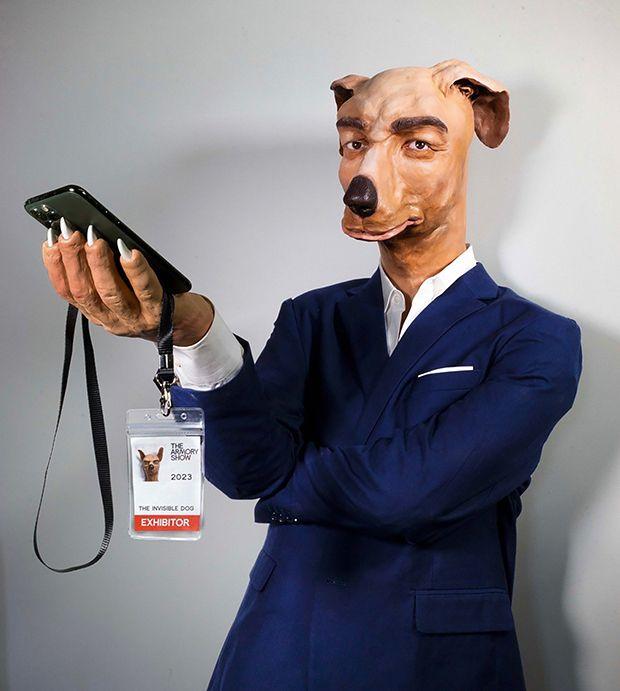While walking through The Armory Show this year, you may notice an unusual collector and gallerist—and not in the typical ways of extravagant outfits or loud eyeglasses. They are dogs, dressed in suits and standing upright like humans. The anthropomorphised canines are sculptures by the artist Stephen Morrison, and part of Brooklyn non-profit the Invisible Dog Art Center’s first-ever stand at a commercial art fair. Morrison’s installation was made specifically for The Armory Show, and the project is the reason the Invisible Dog decided to apply for a booth in the fair’s special non-profit section this year.
“I immediately thought that this ‘mise en abyme’—a satirical representation of the art world in one of the most important art-world events—would be extremely exciting,” says Lucien Zayan, the Invisible Dog’s founder and director. “Morrison’s intention is playful, mocking—at least on the surface—but we think the exhibition will offer visitors an opportunity to reflect on the power structures at play and the effects they have on the practices of artists.”
The installation brings a welcome dose of self-reflexive humour to a fair that some have recently accused of straying too far from its scrappy roots as it expands year after year. “The Armory Show prides itself on being a crossroads for all members of the contemporary arts community,” says Nicole Berry, the fair’s executive director. “Not-for-profit organisations are a critical part of that ecosystem.”
In addition to its usual non-profit centred programming, for its 2023 edition, The Armory Show chose about a dozen non-profits and provided them with booths—albeit smaller than those of the commercial galleries, their prices are heavily subsidised. (In addition, Artists Space was given a free booth as part of the Armory Spotlight programme.) The non-profits represented this year include New York City institutions like the Invisible Dog, Aperture, EFA Robert Blackburn Printmaking Workshop (EFA RBPMW) and the International Studio & Curatorial Program (ISCP), plus others from further afield, including Texas’s Ballroom Marfa, Wave Pool from Ohio and even Tate from the UK.
Each non-profit participating in The Armory Show has taken a distinct approach with its display—whether concentrating on a single artist or packing in as much variety as possible. The out-of-towners are hoping to make New York connections, and many cite a combination of educating fairgoers about their programming and artists, reaching new audiences (including potential new members and even donors) and making and nurturing connections with other non-profits as well as commercial galleries. Selling work is also important to some, especially the organisations whose stands are showcasing prints and editions, like EFA RBPMW, the Skowhegan School of Painting & Sculpture and others.
Zayan says that the Invisible Dog does not feel much “commercial pressure”, as the booth has been funded already. ISCP executive director Susan Hapgood points out that many of the artists who participate in her organisation’s residency programme come from countries where there is not as much need to sell their work thanks to comparatively generous government grants. For ISCP, the goal of the stand—which features a solo presentation by textile artist Sarah Zapata—is primarily visibility.
The Armory Show is not the only fair this season devoting significant floorspace to non-profits. In its inaugural edition, Photofairs is providing free booths to several non-profits, and unlike at The Armory Show next door, they are spread throughout the fair—a sticking point for Photofairs director Helen Toomer, who sees this as representative of integration and good for “visual diversity”. At Magnum Foundation’s Photofairs booth, the organisation is not even selling anything—instead, connecting interested buyers directly with its artists. Meanwhile, at Independent 20th Century—which, in its second year, is again providing a special price on a booth for one non-profit—Hauser & Wirth Institute is displaying the archives of Pakistani Modernist Zahoor ul Akhlaq and American abstractionist Mary Dill Henry.
“It’s benevolent of the art fairs to give non-profits booths. It reflects an acknowledgement that non-profits are part of the ecosystem and deserve to be nurtured,” Hapgood says, pointing out the “levels of mutual interdependence” in the art world—from the non-profits and artist-run spaces that nurture young and up-and-coming artists, to the commercial galleries and museums. She calls the growing presence of non-profits at commercial art fairs a “recognition of the larger collective goals with other institutions”.
Zayan concurs, adding: “Only our approaches and tools are different.”

























